"The animals of the world exist for their own reasons. They were not made for humans any more than black people were made for white, or women created for men." -Alice Walker
This weekend -- perhaps inspired by the growing friendship between our new dog and our old one -- I've got a surprising find along with a sweet White Stripes song for you,
Every once in a while, I'll run across something in the natural world that wholeheartedly surprises me. I remember watching a nature documentary about lions, where I saw a wounded, pregnant lioness leave her pack to give birth. It was no surprise that once night fell, the hyenas began to arrive. The lioness held her ground for a little while, but once the third and fourth hyena showed up, the lioness had no choice but to abandon her cubs to their fate. But the shocking part came moments after her leaving, where a traveling group of leopards came upon the scene, and defended the cubs against the hyenas.
How remarkable, I thought, that a wild animal with no inherent stake in the outcome would interfere simply to protect and help another living creature. Well, it turns out that interspecies animal friendships are far more common than I'd realized. Here are some of my favorites that I've found.
In December 2004, a baby hippopotamus (Owen) orphaned by the Sumatra-Andaman earthquake was rescued and brought to Haller Park. There were no other hippos there, so Owen was placed with Mzee, the park's 130-year-old Aldabra Giant Tortoise. In short order, the two became friends, eventually eating, sleeping, swimming and playing together. When Owen was deemed fit for it three years later, Mzee was removed and a female hippo, Cleo, was brought in.
At Samut Prakan Crocodile Farm and Zoo in Thailand, a two-year-old Chimpanzee, Do Do, took an interest in a two month old Tiger cub named Aorn, and learned to bottle-feed it.
But it isn't only in zoos that this type of unlikely animal friendship is found.
A natural wildlife reserve in China saw a white dove -- believed to be part of a bird migration study -- befriend an abandoned rhesus monkey! For two months, the monkey and the dove shared the same space together and ate the same food: wild corn. The monkey frequently hugged the dove, who -- while she didn't hug back -- was content to let the monkey do so.
In Japan, mother cat Hiroko lost three kittens, leaving her childless. Nearby, a group of spot-billed ducks hatched, and she became their surrogate mom. As far as I know, they are still an adoptive family.
And in perhaps my favorite story of unlikely friendship, a dwarf hamster named Gohan (which means "cooked rice" in Japanese) was given to the three-foot-long rat snake, Aochan, as a live treat, after the snake refused to eat frozen mice. But for months now, they've instead become the best of friends, sharing a cage and everything. According to zookeeper Kazuya Yamamoto of the Tokyo Zoo,
"I've never seen anything like it. Gohan sometimes even climbs onto Aochan to take a nap on his back."
Aochan has learned to eat frozen rodents, but appears to pose no danger to Gohan, and they continue to enjoy one another's company.
Apparently, interspecies friendship (or cross-breed interaction) is much more common than I realized, and even though I may not know the story behind the rest of the images I found, I do still want to share them with you.
I imagine that these two have enough in common to look past their differences and simply enjoy one another's company.
I don't know the story behind these two, but I do know that this is not the first Great Ape / Bunny friendship I've read about.
And to come full-circle to big cats once again, why wouldn't a cheetah make fun with a labrador retriever? (And check here for more interspecies friends pictures.)
Keep your mind open about where your next great friendship might come from; you'll never know what joys might enter your life if you give it a shot!

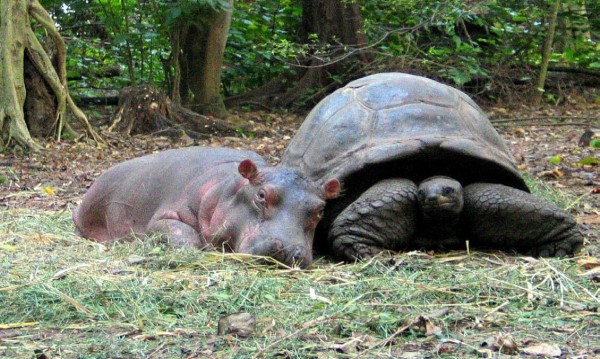
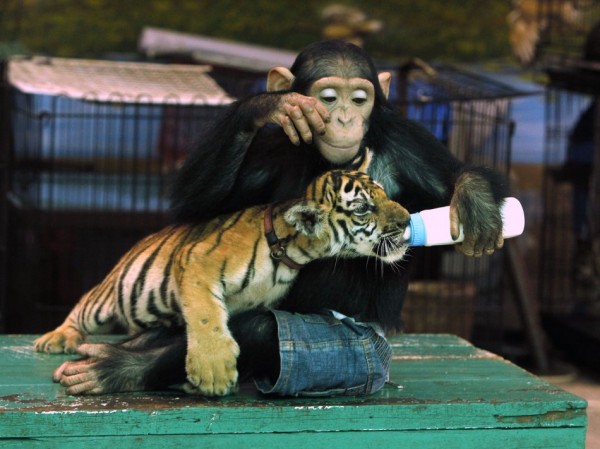
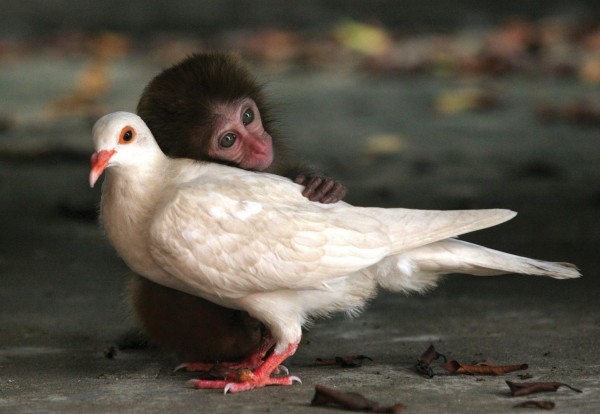

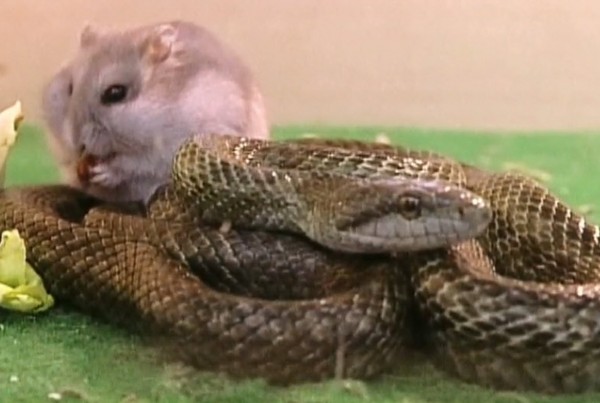
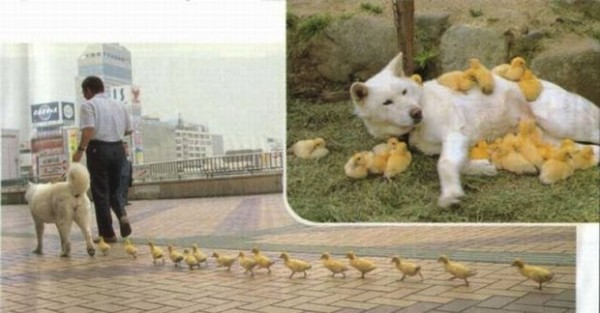
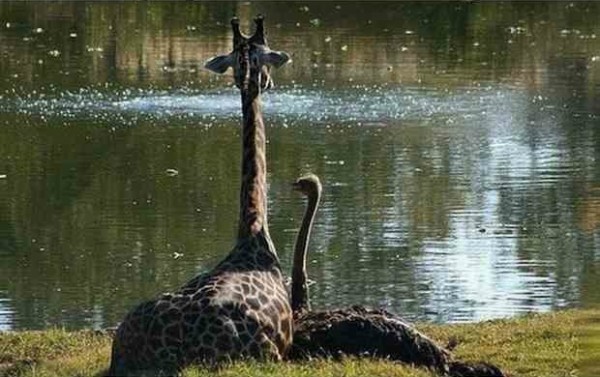
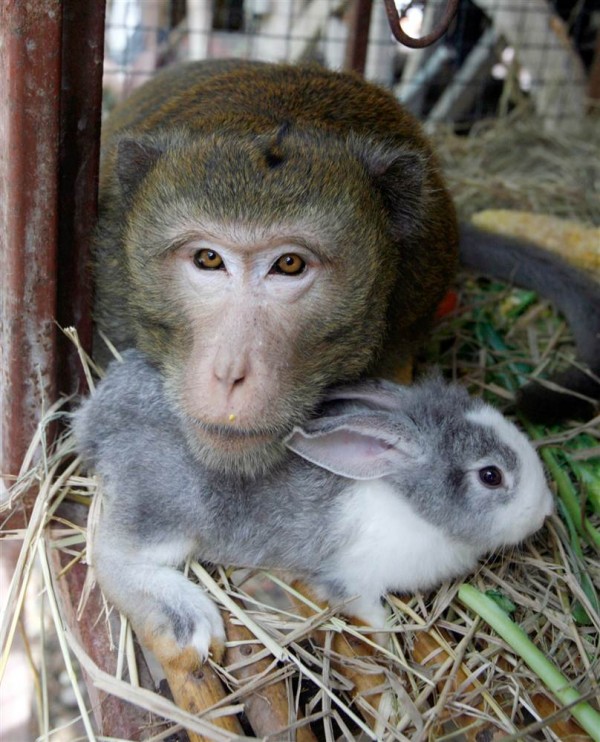
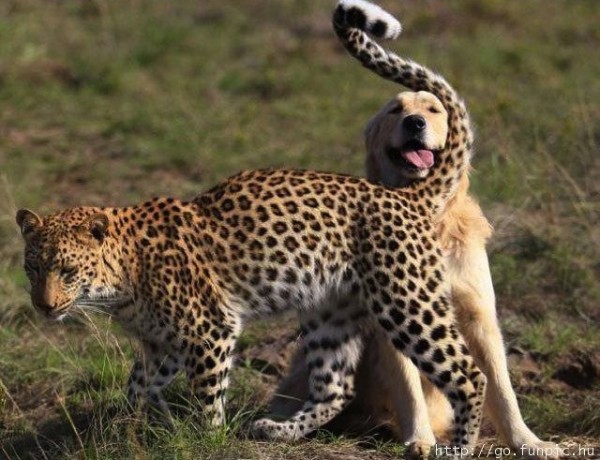
And of course, Koko and Allball.
Pretty sure it's a young leopard and not a cheetah.
Robert,
I confess that I cannot tell a cheetah and leopard apart by looking, but after searching for images, I think you're right, and it probably is a leopard.
I initially said cheetah because I thought there was a chance that it was this pair, but now it looks like I was wrong.
Surely the animal-lovers are outraged by something in this article.
Easy way to tell a cheetah from other cats: they have dark lines going from the eyes down the side of the nose. They're also very slight of build, built more like a greyhound than a cat.
Leopards are much heavier.
OOOOOOOOOOOOOOOH <3 the cutest and most weird couples I've ever seen <3 thank you Ethan sir!
not couples, I meant friendships xD
the one with pigeon and little chimp is really awesome :)
Very interesting photos and topic.
I have no pets.
Though I have had them and respect those who are responsible pet owners.
But I am very interested in wild animals, their behavior and biology.
Those ducklings following the dog. This may be a situation that Konrad Lorentz studied. The first thing that a duckling sees is imprinted on the baby duckling as Mom. Thus Konrad Lorentz would arrange to be the first thing that hacking ducklings saw and the ducklings would follow him all around his farm.
Friendship between people is very important. And also between animals and animal, and people and animals, and cross species as you say.
Though I am not a pet owner or lover. I always talk to animals domestic or wild. Sometimes its words "good boy" or "good girl" and letting them sniff you; as when a dog approaches or as I walk in their territory.
Sometimes it is a sharp clap of my hands as when I am telling the crows that they have done enough damage to my lawn for the day.
But sometimes it is just strange sounds that gurgle up in my voice and throat. Yesterday as my wife, 5 year old son and I were driving through wintry countryside; we came across a herd of two dozen buffalo eating, standing and lying in the snow.
There were young ones and mothers and what appeared to be three large males. The young ones and mothers were all together eating. the large males stood alone. As we walked along the fence I made my strange rhythmic gutteral sounds.
My son was excited; he had never seen buffalo before; my wife took pictures, and I made my nonsense aboriginal sounds. The whole herd of buffalo walked along with us. First up the hill, then down the hill. Yes, they left their food to follow us; just as we had left our car and journey to walk along side them.
Yes, I talk to trees and shrubs and flowers and insects as well as larger animals. (I don't talk to alligators or spiders or snakes).
As a child I learned to approach honey bees upon clover and catch them in my two cupped hands. My friends thought that I was crazy as I then let a captured honey bee walk along my hand until it flew away. I still do this, though not so often.
I make English style bramble hedges of leaves and sticks and berries plants and trees to increase wildlife possibilities to build homes. (in the wild part of our yard). My wife hates it. But it is important to me; so she tolerates it. No branches or leaves that fall in our yard leave our yard. Nature can use its debri right here. I just rearrange it a bit; building hedges and terracing the land (about 1/2 acre).
Even in a much smaller yard I have always had a wild part. Once I had two grave vines. Every year, I'd wait until they were just ripe to pick. and every year the raccoons got them first. And that was OK. (The family of skunks that made a home in my garage was not OK. I humanly encourage them to leave. Several months later I learned that they had moved across the street under a neighbors deck. She tolerated growing skunk family for the summer).
But I also destroy. Twice i've run over yellow jacket nests with a lawn mower. Both times were a comedy for my neighbors to behold as I tried unsuccessfully to outrun the bees. Twenty stings the first time 20 years ago. 15 stings last year.
Both times I considered long. I don't mind the stings so much and I really like the bees; and both times I laughed about the experience even as I counted my stings and wacked the last bees. And for weeks after, I laughed as I told my story of bees chasing me even into the kitchen where I swatted and killed twenty persistently little defenders of their hive.
But both times the bees nests were in the path where children play. So both times, I simply took a log and set it atop the opening of the yellow jacket nest. Of course they died.
Man's friendship with nature is quite one sided like that.
We, the most invasive species upon the planet, fret over some invasive species (by definition less invasive than we humans). And we must fret; because we have a big responsibility.
But we must also, give space for the rest of nature. We must be friends (sometimes cautious friends) of all of nature. But I think it is fair to say that as long as we humans live upon planet earth, we must be caretakers of this planet; that is our responsibility alone to promote a healthy diversity and even to manage evolution (of ourself and other species). We have done so from the beginning through husbandry etc. and it will get morecomplex.
Of course, if humans are gone; nature will be fine and fend for itself and mend itself.
And in caring for nature, we must allow ourself to be inconsistent. OKThen, when you are jabbering to buffalo or trees or..., do you really think they are understanding you? or that you are understanding them?
Yes animals and understand something. Plants follow the sun and know if I am in the way; animals know if I run them over with a lawn mower. And they respond inappropriately.
For example, one day, I took one of my red ear slider turtles and took out my frustration upon him.
He was a big guy about 4 inches in diameter. I was maybe eight years old. I poked him with my finger. I poked him in the nose. He crawled tight in his shell. I poked again; he pushed deeper into his shell until his tail and rear legs pushed out the back of his shell. I poked him again in the nose and he had no where to go.
So my red ear slider turtle stretched out his neck and bit me on the cheek. I screamed and let go. But my red ear slider held tight and swung from my cheek. I dared not pull him off, I could feel the blood run down my cheek; then finally he let go.
I wiped the blood on my face. I was mad at myself. I stooped down and gently picked up my turtle and put him back in his turtle area (a little rock surrounded area with water and plants in my back yard).
My turtle was right. I was wrong. No I'm not arguing that turtles understand concepts of right and wrong. But turtles do understand how to behave correctly as turtles; just as little boys know how to behave correctly as little boys.
And I knew that I had behaved incorrectly as a little boy; and that turtle had behaved correctly as a turtle. Turtle was my pet, my friend; how dare I poke him in the nose?
Even if he was going to be my dinner; there was no need for me to abuse my turtle.
Great story, and I love the Alice Walker quote. It should have been no surprise to anyone that animals [other than Homo sapiens] are capable of interspecies cooperation and friendship. Every time you interact with your dog or cat, he/she is interacting with you, after all. My friendship with my cat is mutually rewarding, entertaining and comforting, despite our imperfect communications and disparate interests and motivations. I can reasonably presume that the friendship between a dog and a cat (or leopard or cheetah) is as well.
There was another leopard raised in an Indian park by a park tender and his small dog (probably many years ago now, as I think I saw it on TV several years ago, and who knows how old it was then). The small dog was the alpha between the two; when the three went on walks, the leopard had to walk behind the dog, or the dog would nip it. :)
***
IMO, this is evidence of evolution at work. Its much easier to evolve "love the first thing you meet" or "love what raises you" compared to "love your genetic parents." The first only requires the senses you've already evolved. Its basically a software change. The second takes some form of DNA-analyzing sense - additional, complex hardware. If the first is just as good as the second most of the time, then you would reasonably expect to see lots of animals that have "love the first thing you meet" instincts. You will only expect to see animals with DNA analyzing equipment when that specific capability provides a huge survival advantage over the lesser capability.
eric,
That doesn't explain it from the point of the surrogate parent, which I think is more to the point.
That is a leopard. Cheetahs have stripes running from their eyes to their mouths. Also, the leopard has rosette spots. Cheetahs have solid spots.
Doug:
Sure it does. "Love the things in your brood/nest" is probably a much more likely and resource-cheap adaptation than "use DNA detector to determine which things in yoru brood/nest are related to you, then love those."
Consider cuckoos; defenses against them have had to evolve as a reaction to the parasite. And they've evolved differently in different parasitized bird species. Prior to cuckoos, birds did not start off with some inborn ability to recognize foreign eggs - probably because there was no need for it. "Raise the eggs in your nest" was just as good an adaptation, and probably a much more likely or easier or cheaper adaptation to evolve.
Now you say it, I can bring back the Attenborough documentaries to mind and remember the solid spots.